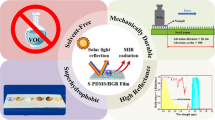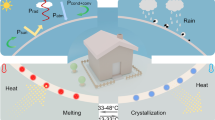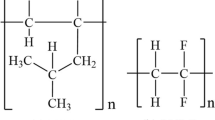Abstract
Daytime radiative cooling is a burgeoning cooling technology that reflects solar irradiation and radiates heat to outer space (3 K) to cool down terrestrial objects without using external energy. However, previously reported radiative cooling materials require complex technology, expensive equipment, or harmful chemicals, most of which are easily contaminated during outdoor applications. In this work, we proposed a simple and eco-friendly method with water as template to fabricate robust superhydrophobic porous polydimethylsiloxane (PDMS) radiative cooling film. The film possesses strong reflectivity and emissivity which results in outstanding cooling performance with ambient temperature drop of 11.52 °C, and has a superhydrophobic property with water contact angle of 165.7° and a sliding angle of 2.1° which results in excellent self-cleaning function. In addition, the prepared film shows low thermal conductivity of 0.1063 W m−1 K−1 which efficiently suppresses the heat exchange because of the air-filled voids within the film. Combining the self-cleaning property to prevent the surface from outdoor contamination or wetting, the film is promising to be widely used for long-term cooling for outdoor applications.
Graphical abstract

A superhydrophobic porous polydimethylsiloxane (S-P-PDMS) daytime radiative cooling film with high reflectivity and emissivity was prepared by a simple and eco-friendly template method, which achieved a cooling effect with sub-ambient temperature drop of 11.52 °C.












Similar content being viewed by others
References
Tao Y, Mao Z, Yang Z et al (2020) Preparation and characterization of polymer matrix passive cooling materials with thermal insulation and solar reflection properties based on porous structure. Energy Build 225:110361. https://doi.org/10.1016/j.enbuild.2020.110361
Yang Z, Mao Z, Xiang B et al (2019) Construction of a binary channel efficient cooling composites with reflective and phase-change properties. Compos Part B Eng 178:107517. https://doi.org/10.1016/j.compositesb.2019.107517
Mandal J, Fu Y, Overvig AC et al (2018) Hierarchically porous polymer coatings for highly efficient passive daytime radiative cooling. Science 362:315–319. https://doi.org/10.1126/science.aat9513
Munday JN (2019) Tackling climate change through radiative cooling. Joule 3:2057–2060. https://doi.org/10.1016/j.joule.2019.07.010
Chae D, Kim M, Jung PH et al (2020) Spectrally selective inorganic-based multilayer emitter for daytime radiative cooling. ACS Appl Mater Interfaces 12:8073–8081. https://doi.org/10.1021/acsami.9b16742
Chen MJ, Pang D, Chen XY et al (2022) Passive daytime radiative cooling: fundamentals, material designs, and applications. EcoMat 4:e12153. https://doi.org/10.1002/eom2.12153
Zhang Q, Wang SH, Wang XY et al (2022) Recent progress in daytime radiative cooling: advanced material designs and applications. Small Methods. https://doi.org/10.1002/smtd.202101379
Carlosena L, Andueza Á, Torres L et al (2021) Experimental development and testing of low-cost scalable radiative cooling materials for building applications. Sol Energy Mater Sol Cells 230:111209. https://doi.org/10.1016/j.solmat.2021.111209
Nilsson T, Niklasson G (1995) Radiative cooling during the day: simulations and experiments on pigmented polyethylene cover foils. Sol Energy Mater Sol Cells 37:93–118. https://doi.org/10.1016/0927-0248(94)00200-2
Granqvist CG, Hjortsberg A, Eriksson TS (1982) Radiative cooling to low temperatures with selectivity IR-emitting surfaces. Thin Solid Films 90:187–190. https://doi.org/10.1016/0040-6090(82)90648-4
Catalanotti S, Cuomo V, Piro G et al (1975) The radiative cooling of selective surfaces. Sol Energy 17:83–89. https://doi.org/10.1016/0038-092x(75)90062-6
Zhou L, Song H, Liang J et al (2019) A polydimethylsiloxane-coated metal structure for all-day radiative cooling. Nat Sustain 2:718–724. https://doi.org/10.1038/s41893-019-0348-5
Wang X, Liu X, Li Z et al (2019) Scalable flexible hybrid membranes with photonic structures for daytime radiative cooling. Adv Funct Mater 30:1907562. https://doi.org/10.1002/adfm.201907562
Shahsafi A, Roney P, Zhou Y et al (2019) Temperature-independent thermal radiation. PNAS 116:26402–26406. https://doi.org/10.1073/pnas.1911244116
Rephaeli E, Raman A, Fan S (2013) Ultrabroadband photonic structures to achieve high-performance daytime radiative cooling. Nano Lett 13:1457–1461. https://doi.org/10.1021/nl4004283
Raman AP, Anoma MA, Zhu L et al (2014) Passive radiative cooling below ambient air temperature under direct sunlight. Nature 515:540–544. https://doi.org/10.1038/nature13883
Yao K, Ma H, Huang M et al (2019) Near-perfect selective photonic crystal emitter with nanoscale layers for daytime radiative cooling. ACS Appl Nano Mater 2:5512–5519. https://doi.org/10.1021/acsanm.9b01097
Baranov DG, Xiao Y, Nechepurenko IA et al (2019) Nanophotonic engineering of far-field thermal emitters. Nat Mater 18:920–930. https://doi.org/10.1038/s41563-019-0363-y
Jeong SY, Tso CY, Wong YM et al (2020) Daytime passive radiative cooling by ultra emissive bio-inspired polymeric surface. Sol Energy Mater Sol Cells 206:110296. https://doi.org/10.1016/j.solmat.2019.110296
Kort-Kamp WJM, Kramadhati S, Azad AK et al (2018) Passive radiative “thermostat” enabled by phase-change photonic nanostructures. ACS Photonics 5:4554–4560. https://doi.org/10.1021/acsphotonics.8b01026
Chen MJ, Pang D, Mandal J et al (2021) Designing mesoporous photonic structures for high-performance passive daytime radiative cooling. Nano Lett 21:1412–1418. https://doi.org/10.1021/acs.nanolett.0c04241
Zhao B, Hu M, Ao X et al (2018) Comprehensive photonic approach for diurnal photovoltaic and nocturnal radiative cooling. Sol Energy Mater Sol Cells 178:266–272. https://doi.org/10.1016/j.solmat.2018.01.023
Wang K, Luo G, Guo X et al (2021) Radiative cooling of commercial silicon solar cells using a pyramid-textured PDMS film. Sol Energy 225:245–251. https://doi.org/10.1016/j.solener.2021.07.025
Chae D, Lim H, So S et al (2021) Spectrally selective nanoparticle mixture coating for passive daytime radiative cooling. ACS Appl Mater Interfaces 13:21119–21126. https://doi.org/10.1021/acsami.0c20311
Peng Y, Chen J, Song AY et al (2018) Nanoporous polyethylene microfibres for large-scale radiative cooling fabric. Nat Sustain 1:105–112. https://doi.org/10.1038/s41893-018-0023-2
Zhao DL, Aili A, Zhai Y et al (2019) Radiative sky cooling: fundamental principles, materials, and applications. Appl Phys Rev 6:021306. https://doi.org/10.1063/1.5087281
Lei MQ, Hu YF, Song YN et al (2021) Transparent radiative cooling films containing poly(methylmethacrylate), silica, and silver. Opt Mater 122:111651. https://doi.org/10.1016/j.optmat.2021.111651
Suwal SR, Ramaswamy AP (2021) Performance of roof-cool paints prepared using organic acrylic polymer binder and inorganic additives for the thermal reduction in buildings. Environ Prog Sustain Energy 41:e13767. https://doi.org/10.1002/ep.13767
Song YN, Ma RJ, Xu L et al (2018) Wearable polyethylene/polyamide composite fabric for passive human body cooling. ACS Appl Mater Interfaces 10:41637–41644. https://doi.org/10.1021/acsami.8b14140
Cheng Z, Han H, Wang F et al (2021) Efficient radiative cooling coating with biomimetic human skin wrinkle structure. Nano Energy 89:106377. https://doi.org/10.1016/j.nanoen.2021.106377
Zu M, Yan F, Lv C et al (2021) Daytime passive radiative cooler using zeolite. J Porous Mater 29:1–8. https://doi.org/10.1007/s10934-021-01143-8
Song J, Qin J, Qu J et al (2014) The effects of particle size distribution on the optical properties of titanium dioxide rutile pigments and their applications in cool non-white coatings. Sol Energy Mater Sol Cells 130:42–50. https://doi.org/10.1016/j.solmat.2014.06.035
You Z, Zhang M, Wang J et al (2021) Experimental study of optical and cooling performances of CuO and TiO2 near-infrared reflective blending coatings. Sol Energy 225:19–32. https://doi.org/10.1016/j.solener.2021.06.061
Ma H, Wang L, Dou S et al (2021) Flexible daytime radiative cooling enhanced by enabling three-phase composites with scattering interfaces between silica microspheres and hierarchical porous coatings. ACS Appl Mater Interfaces 13:19282–19290. https://doi.org/10.1021/acsami.1c02145
Li T, Zhai Y, He SM et al (2019) A radiative cooling structural material. Science 364:760–763. https://doi.org/10.1126/science.aau9101
Al-Kattan A, Wichser A, Zuin S et al (2014) Behavior of TiO2 released from nano-TiO2-containing paint and comparison to pristine nano-TiO2. Environ Sci Technol 48:6710–6718. https://doi.org/10.1021/es5006219
Huang J, Li M, Fan D (2021) Core-shell particles for devising high-performance full-day radiative cooling paint. Appl Mater Today 25:101209. https://doi.org/10.1016/j.apmt.2021.101209
Wang J, Sun J, Guo T et al (2021) High-strength flexible membrane with rational pore architecture as a selective radiator for high-efficiency daytime radiative cooling. Adv Mater Technol. https://doi.org/10.1002/admt.202100528
Yang J, Gao X, Wu Y et al (2020) Nanoporous silica microspheres-ploymethylpentene(TPX) hybrid films toward effective daytime radiative cooling. Sol Energy Mater Sol Cells 206:110301. https://doi.org/10.1016/j.solmat.2019.110301
Srinivasan A, Czapla B, Mayo J et al (2016) Infrared dielectric function of polydimethylsiloxane and selective emission behavior. Appl Phys Lett 109:88–735. https://doi.org/10.1063/1.4961051
Zhao H, Sun Q, Zhou J et al (2020) Switchable cavitation in silicone coatings for energy-saving cooling and heating. Adv Mater 32:e2000870. https://doi.org/10.1002/adma.202000870
Boriskina SV (2016) Nanoporous fabrics could keep you cool. Science 353:986–987. https://doi.org/10.1126/science.aah5577
Hsu PC, Song AY, Catrysse PB et al (2016) Radiative human body cooling by nanoporous polyethylene textile. Science 353:1019–1023. https://doi.org/10.1126/science.aaf5471
Zeng S, Pian S, Su M et al (2021) Hierarchical-morphology metafabric for scalable passive daytime radiative cooling. Science 373:692–696. https://doi.org/10.1126/science.abi5484
Sun Y, Ji Y, Javed M et al (2021) Preparation of Passive daytime cooling fabric with the synergistic effect of radiative cooling and evaporative cooling. Adv Mater Technol. https://doi.org/10.1002/admt.202100803
Yang Z, Zhang J (2021) Bioinspired radiative cooling structure with randomly stacked fibers for efficient all-day passive cooling. ACS Appl Mater Interfaces 13:43387–43395. https://doi.org/10.1021/acsami.1c12267
Yang Z, Sun H, Xi Y et al (2021) Bio-inspired structure using random, three-dimensional pores in the polymeric matrix for daytime radiative cooling. Sol Energy Mater Sol Cells 227:111101. https://doi.org/10.1016/j.solmat.2021.111101
Zhou L, Rada J, Zhang H et al (2021) Sustainable and inexpensive polydimethylsiloxane sponges for daytime radiative cooling. Adv Sci e2102502. https://doi.org/10.1002/advs.202102502
Leroy A, Bhatia B, Kelsall CC et al (2019) High-performance subambient radiative cooling enabled by optically selective and thermally insulating polyethylene aerogel. Sci Adv 5:eaat9480. https://doi.org/10.1016/j.apmt.2021.101100
Zhao YW, Pang D, Chen MJ et al (2022) Scalable aqueous processing-based radiative cooling coatings for heat dissipation applications. Appl Mater Today 26:101298. https://doi.org/10.1016/j.apmt.2021.101298
Chen G, Wang Y, Qiu J et al (2021) A visibly transparent radiative cooling film with self-cleaning function produced by solution processing. J Mater Sci Technol 90:76–84. https://doi.org/10.1016/j.jmst.2021.01.092
Zhong S, Yi L, Zhang J et al (2021) Self-cleaning and spectrally selective coating on cotton fabric for passive daytime radiative cooling. Chem Eng J 407:127104. https://doi.org/10.1016/j.cej.2020.127104
Tian Y, Shao H, Liu X et al (2021) Superhydrophobic and recyclable cellulose-fiber-based composites for high-efficiency passive radiative cooling. ACS Appl Mater Interfaces 13:22521–22530. https://doi.org/10.1021/acsami.1c04046
Wang HD, Xue CH, Guo XJ et al (2021) Superhydrophobic porous film for daytime radiative cooling. Appl Mater Today 24:101100. https://doi.org/10.1016/j.apmt.2021.101100
Chen M, Li W, Tao S et al (2020) A pragmatic and high-performance radiative cooling coating with near-ideal selective emissive spectrum for passive cooling. Coatings 10:144. https://doi.org/10.3390/coatings10020144
Liu SH, Han YM, Qie JQ et al (2022) Environment friendly superhydrophobic and transparent surface coating via layer-by-layer self-assembly for antifogging of optical lenses. J Biomater Sci Polym Ed 33:847–857. https://doi.org/10.1080/09205063.2021.2021353
Xiang B, Zhang R, Luo YL et al (2021) 3D porous polymer film with designed pore architecture and auto-deposited SiO2 for highly efficient passive radiative cooling. Nano Energy 8:105600. https://doi.org/10.1016/j.nanoen.2020.105600
Weng YZW, Zhang WF, Jiang Y et al (2021) Effective daytime radiative cooling via a template method based PDMS sponge emitter with synergistic thermo-optical activity. Sol Energy Mater Sol Cells 230:111205. https://doi.org/10.1016/j.solmat.2021.111205
Liu BY, Xue CH, Zhong HM et al (2021) Multi-bioinspired self-cleaning energy-free cooling coatings. J Mater Chem A 9:24276–24282. https://doi.org/10.1039/D1TA07953K
Chen Y, Mandal J, Li W et al (2020) Colored and paintable bilayer coatings with high solar-infrared reflectance for efficient cooling. Sci Adv 6:eaaz5413. https://doi.org/10.1126/sciadv.aaz5413
Xue CH, Wei RX, Guo XJ et al (2022) Fabrication of superhydrophobic P(VDF-HFP)/SiO2 composite film for stable radiative cooling. Compos Sci Technol 220:109279. https://doi.org/10.1016/j.compscitech.2022.109279
Huang MC, Xue CH, Huang J et al (2022) A hierarchically structured self-cleaning energy-free polymer film for daytime radiative cooling. Chem Eng J 442:136239. https://doi.org/10.1016/j.cej.2022.136239
Chen MJ, Pang D, Chen XY et al (2021) Enhancing infrared emission behavior of polymer coatings for radiative cooling applications. J Phys D Appl Phys 54:295501. https://doi.org/10.1088/1361-6463/abfb19
Zhou L, Rada J, Zhang HF et al (2021) Sustainable and inexpensive polydimethylsiloxane sponges for daytime radiative cooling. Adv Sci 8:2102502. https://doi.org/10.1002/advs.202102502
Zhao YJ, Xie ZY, Gu HC et al (2012) Bio-inspired variable structural color materials. Chem Soc Rev 41:3297–3317. https://doi.org/10.1039/C2CS15267C
Wen CD, Mudawar I (2006) Modeling the effects of surface roughness on the emissivity of aluminum alloys. Int J Heat Mass Transf 49:4279–4289. https://doi.org/10.1016/j.ijheatmasstransfer.2006.04.037
Zhou Z, Wang X, Ma Y et al (2020) Transparent polymer coatings for energy-efficient daytime window cooling. Cell Rep Phys Sci 1:100231. https://doi.org/10.1016/j.xcrp.2020.100231
Aryal A, Chaiwiwatworakul P, Chirarattananon S et al (2022) Subjective assessment of thermal comfort by radiant cooling in a tropical hot humid climate. Energy Build 254:111601. https://doi.org/10.1016/j.enbuild.2021.111601
Song X, Gao Y, Farooq AS et al (2021) Temperature non-uniformity in the radiative cooler and its effect on performance under various humidity conditions. Sol Energy 220:498–508. https://doi.org/10.1016/j.solener.2021.03.064
Bijarniya JP, Sarkar J (2020) Climate change effect on the cooling performance and assessment of passive daytime photonic radiative cooler in India. Renew Sustain Energy Rev 134:110303. https://doi.org/10.1016/j.rser.2020.110303
Liu J, Zhang J, Zhang D et al (2021) Theoretical and experimental research towards the actual application of sub-ambient radiative cooling. Sol Energy Mater Sol Cells 220:110826. https://doi.org/10.1016/j.solmat.2020.110826
Harrison AW (1981) Effect of atmospheric humidity on radiation cooling. Sol Energy 26:243–247. https://doi.org/10.1016/0038-092X(81)90209-7
Park G, Roh K, Kim H et al (2021) Universal experimental methods for evaluating the performance of radiative cooling materials. Adv Mater Technol. https://doi.org/10.1002/admt.202101205
Jing WL, Zhang S, Zhang W et al (2021) Scalable and flexible electrospun film for daytime subambient radiative cooling. ACS Appl Mater Interfaces 13:29558–29566. https://doi.org/10.1021/acsami.1c05364
Acknowledgements
This work was supported by the National Natural Science Foundation of China (52103263), Key Research and Development Program of Shaanxi Province (2020ZDLGY13-11), China, Postdoctoral Science Foundation (2020M683410), a major project of Ministry of Science and Technology of China (2017YFB0307700).
Author information
Authors and Affiliations
Contributions
T. T. F. and C. H. X. conceived the research and designed the experiments. C. H. X. and X. J. G. supervised the research. T. T. F., X. J. G., H. D. W., M. C. H., D. M. Z. and F. Q. D. carried out the experiment. T. T. F. and C. H. X. built the analytical models. All authors analyzed the data. T. T. F. and C. H. X. interpreted the data. T. T. F., C. H. X. and X. J. G. wrote the paper.
Corresponding authors
Ethics declarations
Conflict of interest
The authors declare that they have no known competing financial interests or personal relationships that could have appeared to influence the work reported in this paper.
Additional information
Handling Editor: Gregory Rutledge.
Publisher's Note
Springer Nature remains neutral with regard to jurisdictional claims in published maps and institutional affiliations.
Supplementary Information
Below is the link to the electronic supplementary material.
Supplementary file2 (MP4 54079 kb)
Rights and permissions
About this article
Cite this article
Fan, TT., Xue, CH., Guo, XJ. et al. Eco-friendly preparation of durable superhydrophobic porous film for daytime radiative cooling. J Mater Sci 57, 10425–10443 (2022). https://doi.org/10.1007/s10853-022-07292-8
Received:
Accepted:
Published:
Issue Date:
DOI: https://doi.org/10.1007/s10853-022-07292-8




